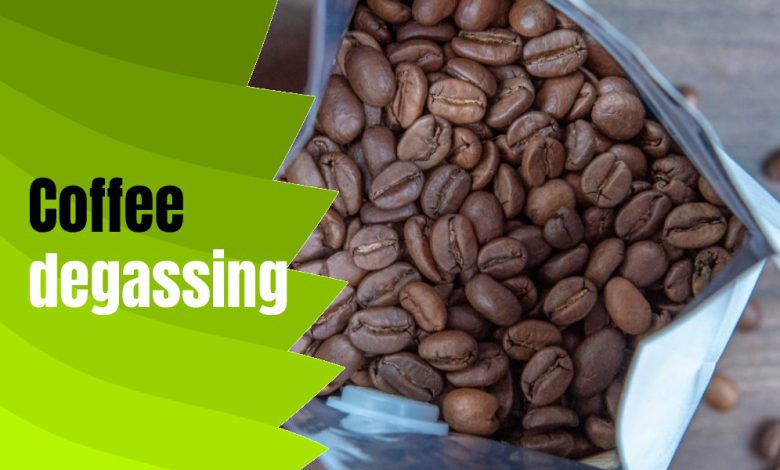How To Degas Coffee? (The Effects And Points Of Increasing The Speed Of Degassing)

Coffee degassing looks to be a simple process. But, allowing the carbon dioxide to escape the coffee can have a profound effect on the taste and flavor of the final cup of coffee that consumers drink.
It needs time to let the carbon dioxide be released from cell structures after roasting the beans. But, by letting the CO2 to reach its optimal level, degassing helps to have a flavorful coffee.
As you know, there are several factors that influence the taste and aroma of your cup of coffee. The right and even extraction of coffee compounds is one them. But, the extraction efficiency depends on the level of gases inside coffee structure.
To help you learn more about the importance of this process, we’re going to discuss about the degassing and the time you need to wait after roasting of coffee beans to let CO2 reach its right level.
read more: Coffee Vs Cappuccino
Contents
- 1 WHY IS THERE CARBON DIOXIDE IN COFFEE ANYWAY?
- 2 How long should I let coffee degas?
- 3 Why is degassing important in coffee?
- 4 Does ground coffee need to degas?
- 5 How long should you let coffee sit after roasting?
- 6 How long does coffee need to degas after roasting?
- 7 How do you degas coffee after roasting?
- 8 Coffee degassing time
- 9 How to degas coffee after roasting?
- 10 Speed up coffee degassing
- 11 Frequently asked questions:
- 12 How long does it take to degas coffee?
- 13 Does coffee degassing changes the flavor profile?
- 14 How coffee degases after roasting?
- 15 How CO2 can escape from beans?
- 16 How coffee degases after roasting?
- 17 How CO2 can escape from beans?
- 17.1 How much co2 will be released during roasting?
- 17.2 How much coffee can escape from coffee after roasting and before brewing?
- 17.3 Is grinding can help coffee degassing?
- 17.4 Do green beans have co2?
- 17.5 Does coffee degassing allow us to have a better drink?
- 17.6 Do we have other gases in the bean?
- 17.7 Is it possible to brew coffee without letting it to degas?
- 17.8 Is waiting for 1 day is enough for degassing?
- 17.9 Does waiting too long for degassing destroys the freshness of coffee?
- 17.10 Does coffee degassing allow co2 to leave the beans completely?
- 17.11 How do I know if it is the right time for brewing or not?
- 17.12 Do I need to consider roasting date on the label of products?
- 17.13 Why do we have pressure inside beans after roasting?
- 17.14 How much co2 leaves the beans after 24 hours?
- 17.15 Does the size of whole beans matter in degassing?
- 17.16 Is it a good idea to grind coffee for degassing?
- 17.17 Does level of roasting matter in degassing?
- 17.18 Does level of roasting affect the level of gas?
- 17.19 is degassing coffee necessary؟
- 17.20 Does roasting makes coffee stale?
- 17.21 Do we need to consider level of roasting for degassing process?
- 17.22 Does dark roast coffee degas faster?
- 17.23 Does the rate of heat changes coffee degassing speed?
- 17.24 Do we need to let coffee bloom?
- 18 Final word
WHY IS THERE CARBON DIOXIDE IN COFFEE ANYWAY?
During roasting, coffee beans undergo many difference chemical reactions. Complex carbohydrates are broken down into smaller molecules, beans begin to brown, and a lot of water vapour and carbon dioxide are created.
When you hear or see first crack, this is actually the build-up of gases causing enough pressure to break the bean’s cell wall. But the development of gases continues throughout the roast.
Ensei Neto is the founder of The Coffee Traveler. He tells me that “the most important chemical reaction is at the end of roasting, because [this is] when conversion of sugar happens. When the energy is released, it makes gas.”
read more: Cafes And Coffee Shops In Hanoi
How long should I let coffee degas?
After harvesting and producing green coffee beans, one of the main processes that is required for the preparation of beans for brewing coffee is the roasting process.
In this process, by applying the heat, the coffee beans will be ready to be grinded and used for brewing.
But, the roasting process changes several compounds in the coffee beans. This leads to the formation of several gases inside the roasted coffee beans.
The majority of the gases that are created during roasting process is carbon dioxide.
This gas has to be released to let coffee sit before brewing.
read more: Best Portable Coffee Bags For Camping
Minimum required time for coffee degassing
During roasting process, some of carbon dioxide leaves the beans. But, a large portion of gases need time to be gradually released. Therefore, some coffee roasters or ordinary people ask about the time that is required to let carbon dioxide to escape the beans.
As coffee degassing is vital for having a better drink, it seems that at least you need 1 day to let gases escape the beans.
It lets coffee brewers to prepare a drink with a better taste and aroma for consumers who look for the right extraction of coffee compounds.
read more: Types Of Coffee Beans
Why is degassing important in coffee?
For sure, coffee degassing affects the extraction of coffee compound and is considered as one of the major indicators of the freshness. It is also important in packaging and the shelf life of coffee.
If you use freshly roasted beans, right after the roasting process, the presence of carbon dioxide can lead to uneven extraction of coffee compounds from the grinded beans.
On the other side of coin, if you let all the carbon dioxide to escape the coffee beans, you will have a drink with a flat and stale flavor.
Degassing can even have a great impact on the sensory profile of your beverage.
read more: Coffee Belt
Does ground coffee need to degas?
Yes. But, remember that you should not let all the gases to escape the coffee. Therefore, degassing is just necessary and vital to some extent.
This is the main reason that we have different opinion about the ideal time that coffee roasters should let the gases escape the coffee.
read more: Coffee vs Red Bull
is roasting date is important?
Yes. Some people and professional roasters believe that when you buy fresh coffee, it is important to look at the roast date. It helps you to know about the level of carbon dioxide in the coffee.
How long should you let coffee sit after roasting?
As we mentioned above, to reach the optimal level of carbon dioxide in the coffee, it is necessary to let it sit and become ready for brewing a flavorful drink.
In a quantitative point of view, if you let the coffee to sit for 24 hours after roasting, around 40 percent of carbon dioxide escapes the beans. This is due to the presence of pressure inside the beans structure.
But, after first 24 hours, the coffee degassing slows down and depend on the ground size or the size of beans the process can take longer.
read more: Coffee Screen Size
How long does coffee need to degas after roasting?
Depend on the surface of the beans, different coffees may need different time to degas. Smaller surfaces prevent the gases to escape the coffee.
Therefore, by increasing the surface area, for example by grinding the beans, it is easier to let carbon dioxide leave the coffee grounds. But, grinding can expose coffee to the oxygen. Therefore, you need to be more careful!
As a whole, depend on the case, it may take between 1 day to 5 days and even 2 weeks for the process. Finally, you can have the optimal level of CO2 in coffee.
read more: Best Coffee For Winter
How do you degas coffee after roasting?
For coffee degassing, you just need time to let gases leave the bean after roasting. Therefore, the process does not need any special equipment or material to help carbon dioxide escape the roasted coffee.
The only thing that you can do is to grind the whole beans to smaller size. This can let the surface to increase. Therefore by breaking the structure of beans, the speed of degassing (as well as oxidation) will increase.
Coffee degassing time
The best coffee degassing time is determined by the time that you need to reach the optimal or right level of carbon dioxide. But the important not here is that several factors may have a great effect on the coffee degassing time.
Roast profile
The level of roasting will make different level of changes in coffee compounds. Therefore, the amount of the gases inside coffee structure depends on roasting level.
When, you roast the coffee to dark level, the heat changes the beans’ structure. The longer the beans are in high temperature; the more expansive cell structure will become. This means that dark roast coffee will become stale quicker than a light roast coffee.
For this reason, some professional coffee roasters recommend to use a label and mention the roast level and date of roasting as well as the time or the number of days that you need to wait before brewing coffee.
read more: Kaya Kopi Luwa
Coffee Variety
Different varieties may have different compounds. This means that the formation of carbon dioxide is different in each variety. Therefore, the degassing time in not similar for all types of coffee.
Therefore, you may need to wait up to two weeks to let the carbon dioxide reach the right level.
For example, for natural coffee beans that stayed in the cherry, the required time for degassing is more than washed coffee.
Is there a universally accepted time for degassing?
No. Due to the differences between the roast profile and the types of coffee, there is no universally accepted time for coffee degassing.
But, there are rules that says it takes anywhere between 2 days to 2 weeks until the roasted coffee becomes ready for brewing.
There are other rules that says:
- Dark roast coffees degas faster than light roasted coffee
- The longer it takes to roast the beans; the faster degassing will happen.
- In the first day, around 40 percent of carbon dioxide escapes the coffee.
read more: Cowboy Coffee
Is fresh coffee always the best?
No. You need to dive into the world of degassing to understand that using the coffee that is roasted right before grinding and brewing is not a good idea to have a flavorful coffee.
How to degas coffee after roasting?
The best way to let carbon dioxide escape the roasted bean is to wait for at least 24 hours. Many coffee roasters recommend to wait for between 2 to 12 days.
We will mention later that even by grinding the beans, the speed of degassing increases. But, due to the oxidation of coffee compounds, it is not always recommended.
Speed up coffee degassing
how to degas coffee beans faster?
read more: Coffee Processing And Drying
Grinding
Grinding breaks the cells and lets the gases to release in a matter of hours. therefore, when you grind the roasted beans, coffee degassing will speed up. But, keep in mind that it is not a good way for degassing. Because, it can make you coffee stale.
On the other hand, by grinding, you are exposing the coffee compounds to oxygen. This will speed up oxidation of coffee compounds.
Dark roasting
To speed up coffee degassing, you can dark roast the coffee beans or to roast them slowly.
read more: Vienna Coffee
Let coffee bloom
Finally, you can let the coffee ground to degas during brewing. In other word, it’s possible to let fresh coffee bloom before brewing.
To do this, simply make the grounds wet and let them to bloom for around 30 seconds. This process can release carbon dioxide in a matter of seconds.
Frequently asked questions:
How long does it take to degas coffee?
It’s important to mention that how much do you want coffee to degas is the defining factor.
It depends on the case; Do you want it to lose 40 percent of its carbon dioxide?
Do you want whole co2 to escape the coffee?
Or do you want carbon dioxide to reach its optimal level?
Not all the baristas have the same idea. But, in many cases, to reach an optimal level, you need to wait around 2 days up to 2 weeks.
read more: Store Bean And Ground Coffee At Home
Does coffee degassing changes the flavor profile?
Yes, coffee degassing can have a great effect on the overall taste and flavor profile of coffee.
So, even it seems to be a simple process, but, the final taste of your coffee will change a lot with right degassing of coffee (both before brewing and when you’re are preparing your drink).
How coffee degases after roasting?
Releasing the gas from the cell structure is a natural and simple process that only needs time.
How CO2 is produced inside beans?
As we mentioned, the carbon dioxide is one of the main components that are produced during roasting process.
How CO2 can escape from beans?
This gas releases in three stage:
- During roasting process
- After roasting and before brewing
- During brewing the coffee grounds
How much co2 will be released during roasting?
It depends on two factors:
- The level of roasting
- The speed of roasting
So, there is no exact answer in term of percentage of gas releasing. But, usually less than half of carbon dioxide leaves the beans after 24 hours.
How much coffee can escape from coffee after roasting and before brewing?
The speed of coffee degassing after its roasting depends on several factors including type of coffee and its surface.
read more: Malabar Monsoon Ground Coffee
Is grinding can help coffee degassing?
Yes. The area or surface of roasted coffee is one the main defining factors in this process. If you grind coffee beans, the surface of cell structure increases and lets the carbon dioxide to be released faster.
So, coffee ground degases faster. The finer the grounds, the more co2 can escape the roasted coffee.
Do green beans have co2?
Green beans that are harvested from coffee plant do not have carbon dioxide. This gas is one of the components that are produced during roasting process.
Does coffee degassing allow us to have a better drink?
Yes, of course! Even extraction of coffee is one of the main reasons that baristas can brew consistent and delicious drinks.
A tasty drink needs all flavorful contents of coffee to be extracted uniformly. Coffee degassing can help the process and give a better result.
How coffee degases after roasting?
Releasing the gas from the cell structure is a natural and simple process that only needs time.
How CO2 is produced inside beans?
As we mentioned, the carbon dioxide is one of the main components that are produced during roasting process.
How CO2 can escape from beans?
This gas releases in three stage:
- During roasting process
- After roasting and before brewing
- During brewing the coffee grounds
read more: Liberica Coffee
How much co2 will be released during roasting?
It depends on two factors:
- The level of roasting
- The speed of roasting
So, there is no exact answer in term of percentage of gas releasing. But, usually less than half of carbon dioxide leaves the beans after 24 hours.
How much coffee can escape from coffee after roasting and before brewing?
The speed of coffee degassing after its roasting depends on several factors including type of coffee and its surface.
Is grinding can help coffee degassing?
Yes. The area or surface of roasted coffee is one the main defining factors in this process. If you grind coffee beans, the surface of cell structure increases and lets the carbon dioxide to be released faster.
So, coffee ground degases faster. The finer the grounds, the more co2 can escape the roasted coffee.
read more: Coffee Belt
Do green beans have co2?
Green beans that are harvested from coffee plant do not have carbon dioxide. This gas is one of the components that are produced during roasting process.
Does coffee degassing allow us to have a better drink?
Yes, of course! Even extraction of coffee is one of the main reasons that baristas can brew consistent and delicious drinks.
A tasty drink needs all flavorful contents of coffee to be extracted uniformly. Coffee degassing can help the process and give a better result.
Do we have other gases in the bean?
Yes, but, the majority of gases inside coffee beans after applying the heat is carbon dioxide. So, it’s more important.
Is it possible to brew coffee without letting it to degas?
Yes, you can brew your drink right after roasting coffee beans. The only thing that you need to do is grinding coffee beans and using an espresso machine or pot to prepare your drink.
But, the final taste and aroma of the drink is not as good as when you let it degas. Because, the level of caffeine and coffee extraction in each case will change the flavor profile of your cup of coffee.
For this reason, almost all baristas believe that coffee degassing is vital for having a flavorful drink with a delicious taste.
Is waiting for 1 day is enough for degassing?
Many people wait just for 1 day and then grind the coffee to use it for brewing process.
You can try this method and then compare the final result with the time that you wait for a longer time.
Does waiting too long for degassing destroys the freshness of coffee?
Yes, everything has a limit. Waiting too long for degassing of coffee can destroy its freshness. That’s why many people are asking for the optimal time to wait after roasting the coffee beans.
Does coffee degassing allow co2 to leave the beans completely?
Waiting too long can let almost all the gases to escape the coffee. But, it is not recommended at all. Why?
A flat and stale flavor is the only outcome of waiting too long and letting all the gases to escape the beans.
How do I know if it is the right time for brewing or not?
By experience! Different baristas may recommend you to wait for a specific period of time.
But, based on the level of roasting and type of coffee, which is either in form of whole beans or coffee ground, you can find the right time to let co2 escape the bean or grounds.
Do I need to consider roasting date on the label of products?
Yes, of course. Roasting date of coffee beans is an important indicator of its freshness.
So, it’s not just the type or origin of coffee that is important. Roasting date can also give you a better idea about how fresh your final cup of coffee will taste.
read more: Cascara Tea
Why do we have pressure inside beans after roasting?
Presence of carbon dioxide inside coffee beans creates pressure. This is the main reason that coffee degassing takes place naturally over the time.
How much co2 leaves the beans after 24 hours?
Several estimations show that nearly 40 percent of carbon dioxide leaves coffee beans in the first day after roasting.
Does the size of whole beans matter in degassing?
Yes. The surface of whole beans is one of the defining factors that speeds up degassing process. This means that the bean size matters to some extends.
Is it a good idea to grind coffee for degassing?
If you want to brew your coffee tomorrow or the day after that, it can be good idea to grind whole beans. It speeds up degassing by breaking the structure of coffee and letting co2 to escape.
But, in the presence of oxygen, the coffee freshness and quality degrades. So, for example, if you want to brew coffee next weeks, it is better to keep whole beans and grind them later just before brewing.
Does level of roasting matter in degassing?
Level of roasting matters for several reasons. First of all, it has a great impact on the level of change in coffee compounds.
Does level of roasting affect the level of gas?
Yes. The level of gas inside bean directly depends on the level of roasting. It expands cell structure by producing gas.
is degassing coffee necessary؟
degassing coffee is necessary. However, it can help to improve the flavor of the coffee by allowing the flavor to develop more fully.
Does roasting makes coffee stale?
Not always, but, dark roast coffee becomes stale quicker than medium to light roast coffee.
Do we need to consider level of roasting for degassing process?
Yes, level of roasting is as much as important the date of roasting.
Therefore, coffee roasters need to tell more about the roasting level, and the time that their customers have to wait before brewing.
Does dark roast coffee degas faster?
Yes, if both dark roast and light roast beans have the same surface, the dark roast degases faster.
Does the rate of heat changes coffee degassing speed?
Yes, when you apply lower heat to the beans, it takes longer to roast them. So, while you’re roasting, degassing will happen faster.
Do we need to let coffee bloom?
Blooming is the final stage of degassing process. Especially, if you grind and brew coffee beans right after roasting, you need to let it bloom.
It takes less than a minute for fresh roasted coffee to bloom, but the final taste and aroma will change significantly.
So, if you want a delicious and fresh cup of coffee, let it bloom for around 30 seconds.
read more: numbers on side of coffee pot
Final word
Coffee degassing is an important process that lets better extraction of coffee compounds. But, remember that degassing needs a specific period of time until the carbon dioxide reaches its optimal level.
If you wait too long, the coffee will become stale. On the other hand, if you use freshly roasted coffee, the carbon dioxide prevents the even extraction of the coffee compounds.
Therefore, it is recommended to consult coffee roasters. They will tell you about the best time to wait coffee degas before brewing a flavorful drink.








